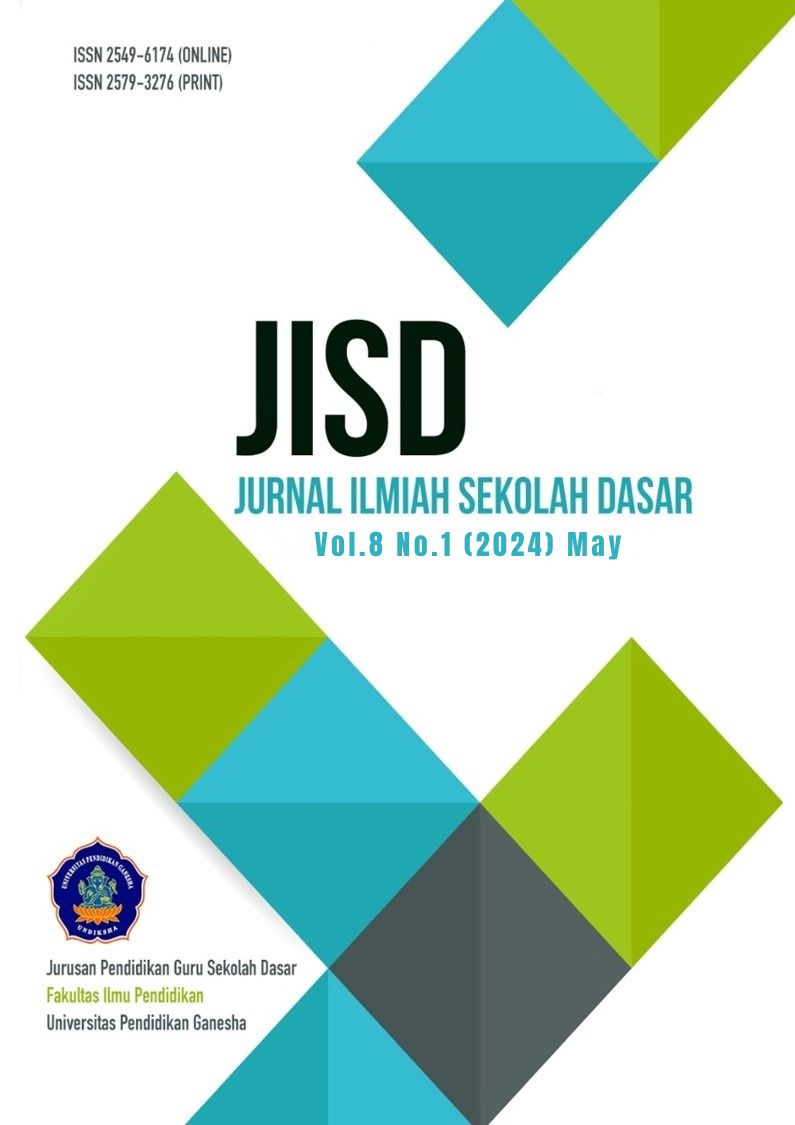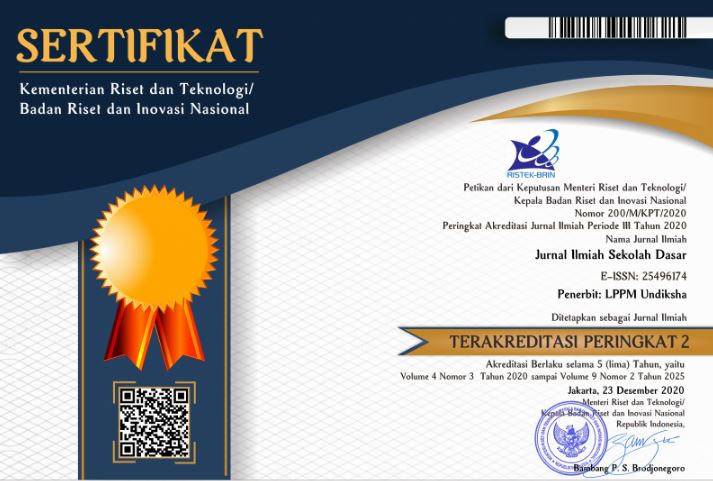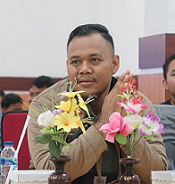Increase Reading Comprehension and Critical Thinking through Reading Stories
DOI:
https://doi.org/10.23887/jisd.v8i2.66783Keywords:
teaching materials, reading comprehension, critical thinkingAbstract
The successful implementation of the teacher's learning process in Indonesian language lessons in elementary schools depends on students' understanding of basic reading and critical thinking skills. The aim of the research is to develop teaching modules in developing students' reading and critical thinking skills (DRTA) models in improving reading and critical thinking from the fourth grade elementary school students. This research was conducted using a descriptive methodology with a combination of development and research (R&D) approaches using the ADDIE design. In carrying out this research, data collection techniques were used which included defining the early stages of module development and prototype design, as well as preparing the module draft. Data collection through interviews, observation, documentation, and literature studies. The data analysis technique used is descriptive statistical analysis technique and inferential statistical analysis of research findings showing a significant increase in various fields among grade 4 students with a total of 25 students. In particular, there was a significant improvement in their ability to initial reading ability material and think critically by applying DRTA. Thus the DRTA model can improve the ability to think, read, understand and think critically.
References
Abdurrahman, A., Maulina, H., Nurulsari, N., Sukamto, I., Umam, A. N., & Mulyana, K. M. (2022). Impacts of Integrating Engineering Design Process into Stem Makerspace on Renewable Energy Unit to Foster Students’ System Thinking Skills. SSRN Electronic Journal, 9(4), e15100. https://doi.org/10.2139/ssrn.4257526. DOI: https://doi.org/10.1016/j.heliyon.2023.e15100
Adnan, A., & Romli, R. (2022). A Comparative Evaluation on Methods of Teaching Computer Programming. In Lecture Notes on Data Engineering and Communications Technologies (Vol. 127, pp. 571–582). Springer Science and Business Media Deutschland GmbH. https://doi.org/10.1007/978-3-030-98741-1_47. DOI: https://doi.org/10.1007/978-3-030-98741-1_47
Agustiningsih. (2015). Video sebagai alternatif media pembelajaran dalam rangka mendukung keberhasilan penerapan kurikulum 2013 di sekolah dasar. PEDAGOGIA: Jurnal Pendidikan, 4(1), 55–68. https://doi.org/10.21070/pedagogia.v4i1.72. DOI: https://doi.org/10.21070/pedagogia.v4i1.72
Alam, A. (2022). A Digital Game based Learning Approach for Effective Curriculum Transaction for Teaching-Learning of Artificial Intelligence and Machine Learning. 2022 International Conference on Sustainable Computing and Data Communication Systems (ICSCDS), 69–74. https://doi.org/10.1109/ICSCDS53736.2022.9760932. DOI: https://doi.org/10.1109/ICSCDS53736.2022.9760932
Ardiyanti, Y. (2016). Berpikir Kritis Siswa Dalam Pembelajaran Berbasis Masalah Berbantuan Kunci Determinasi. JPI (Jurnal Pendidikan Indonesia), 5(2), 193. https://doi.org/10.23887/jpi-undiksha.v5i2.8544. DOI: https://doi.org/10.23887/jpi-undiksha.v5i2.8544
Azizi, Z., Namaziandost, E., & Rezai, A. (2022). Potential of podcasting and blogging in cultivating Iranian advanced EFL learners’ reading comprehension. Heliyon, 8(5), e09473. https://doi.org/10.1016/j.heliyon.2022.e09473. DOI: https://doi.org/10.1016/j.heliyon.2022.e09473
Bashith, A. (2017). Evaluasi Program Praktik Kerja Lapangan Dalam Pemberlakuan Magang Pada Kurikulum Jurusan Pendidikan Ilmu Pengetahuan Sosial Berbasis Kkni. J-PIPS (Jurnal Pendidikan Ilmu Pengetahuan Sosial), 3(2), 112. https://doi.org/10.18860/jpips.v3i2.6859. DOI: https://doi.org/10.18860/jpips.v3i2.6859
Connolly, P., Sebba, J., Winter, K., Roberts, J., Tah, P., & Millen, S. (2023). The effectiveness of book-gifting programmes to enhance the reading skills of children in care: A randomised controlled trial of ‘Reading Together’ in England. Children and Youth Services Review, 153(March 2022), 107097. https://doi.org/10.1016/j.childyouth.2023.107097. DOI: https://doi.org/10.1016/j.childyouth.2023.107097
Cortez, C. A., Yuefan Shao, I., Seamans, M. J., Dooley, E. E., Pettee Gabriel, K., & Nagata, J. M. (2023). Moderate-to-vigorous intensity physical activity among U.S. adolescents before and during the COVID-19 pandemic: Findings from the Adolescent Brain Cognitive Development Study. Preventive Medicine Reports, 35(November 2022), 102344. https://doi.org/10.1016/j.pmedr.2023.102344. DOI: https://doi.org/10.1016/j.pmedr.2023.102344
Daga, A. T. (2021). Makna Merdeka Belajar dan Penguatan Peran Guru di Sekolah Dasar. Jurnal Educatio FKIP UNMA, 7(3), 1075–1090. https://doi.org/10.31949/educatio.v7i3.1279. DOI: https://doi.org/10.31949/educatio.v7i3.1279
Damaianti, V. S. (2021). Strategi Regulasi Diri dalam Peningkatan Motivasi Membaca. Deiksis: Jurnal Pendidikan Bahasa Dan Sastra Indonesia, 8(1), 52. https://doi.org/10.33603/dj.v8i1.4613. DOI: https://doi.org/10.33603/dj.v8i1.4613
Diprossimo, L., Ushakova, A., Zoski, J., Gamble, H., Irey, R., & Cain, K. (2023). The associations between child and item characteristics, use of vocabulary scaffolds, and reading comprehension in a digital environment: Insights from a big data approach. Contemporary Educational Psychology, 73(February), 102165. https://doi.org/10.1016/j.cedpsych.2023.102165. DOI: https://doi.org/10.1016/j.cedpsych.2023.102165
Dubicki, E. (2019). Mapping curriculum learning outcomes to ACRL’s Framework threshold concepts: A syllabus study. Journal of Academic Librarianship, 45(3), 288–298. https://doi.org/10.1016/j.acalib.2019.04.003. DOI: https://doi.org/10.1016/j.acalib.2019.04.003
Ekawati, R., Susetyarini, E., Pantiwati, Y., & Husamah, H. (2016). Peningkatan Hasil Belajar Dan Kemampuan Berpikir Kritis Dengan Model Pembelajaran Cooperative Integrated Reading And Composition (Circ). JPBI (Jurnal Pendidikan Biologi Indonesia), 1(3). https://doi.org/10.22219/jpbi.v1i3.2662. DOI: https://doi.org/10.22219/jpbi.v1i3.2662
Erawanto, U., & Santoso, E. (2016). Pengembangan Modul Pembelajaran Berbasis Masalah Untuk Membantu Meningkatkan Berfikir Kreatif Mahasiswa. JINoP (Jurnal Inovasi Pembelajaran), 2(2), 427. https://doi.org/10.22219/jinop.v2i2.2629. DOI: https://doi.org/10.22219/jinop.v2i2.2629
Fathiara, A., Badarudin, B., & Muslim, A. H. (2019). Meningkatkan Keterampilan Berpikir Kritis Dan Gemar Membaca Peserta Didik Melalui Model Predict Observe Explain Berbasis Literasi. Muallimuna : Jurnal Madrasah Ibtidaiyah, 4(2), 92–101. https://doi.org/10.31602/muallimuna.v4i2.1863. DOI: https://doi.org/10.31602/muallimuna.v4i2.1863
Fonseca, M. da C. F. R. (2020). Numeracy in Youth and Adult Basic Education: syntactic, semantic, and pragmatic dimensions of a discursive practice. ZDM, 52(3), 395–406. https://doi.org/10.1007/s11858-019-01110-3. DOI: https://doi.org/10.1007/s11858-019-01110-3
Giacomazzi, M., Fontana, M., & Camilli Trujillo, C. (2022). Contextualization of critical thinking in sub-Saharan Africa: A systematic integrative review. Thinking Skills and Creativity, 43(October 2020). https://doi.org/10.1016/j.tsc.2021.100978. DOI: https://doi.org/10.1016/j.tsc.2021.100978
Guo, D., Wright, K. L., & McTigue, E. M. (2018). A content analysis of visuals in elementary school textbooks. Elementary School Journal, 119(2), 244–269. https://doi.org/10.1086/700266. DOI: https://doi.org/10.1086/700266
Haryati, S. (2019). Directed reading thinking activity untuk meningkatkan kemampuan membaca siswa sekolah dasar. Teacher in Educational Research, 1(2), 58. https://doi.org/10.33292/ter.v1i2.18. DOI: https://doi.org/10.33292/ter.v1i2.18
Hermawan, R., Rumaf, N., & Solehun, S. (2020). Pengaruh Literasi terhadap Keterampilan Membaca pada Siswa Kelas IV SD Inpres 12 Kabupaten Sorong. Jurnal Papeda: Jurnal Publikasi Pendidikan Dasar, 2(1), 56–63. https://doi.org/10.36232/jurnalpendidikandasar.v2i1.411. DOI: https://doi.org/10.36232/jurnalpendidikandasar.v2i1.411
Hubers, F., Cucchiarini, C., & van der Sijs, N. (2022). Knowledge of idiomatic expressions in the native language: Do emigrants lose their touch? Lingua, 271, 103242. https://doi.org/10.1016/j.lingua.2022.103242. DOI: https://doi.org/10.1016/j.lingua.2022.103242
Huda, M. (2018). Strategi Berpikir Integratif Dalam Pembelajaran Membaca Lintas Kurikulum Di Sekolah Dasar. KREDO : Jurnal Ilmiah Bahasa Dan Sastra, 1(2). https://doi.org/10.24176/kredo.v1i2.1995. DOI: https://doi.org/10.24176/kredo.v1i2.1995
Kim, J. Y., & Kim, E. (2021). Effect of positive parenting styles as perceived by middle school students on academic achievement and the mediation effect of self-esteem and academic engagement. Sustainability, 13(23), 13233. https://doi.org/10.3390/su132313233. DOI: https://doi.org/10.3390/su132313233
Komala, A. S., & Rifai, I. (2021). The Impacts of the Cherry Orchard Video Game on Players’ Reading Comprehension. Procedia Computer Science, 179(2019), 368–374. https://doi.org/10.1016/j.procs.2021.01.018. DOI: https://doi.org/10.1016/j.procs.2021.01.018
Konstantinidou, E., & Scherer, R. (2022). Teaching with technology: A large-scale, international, and multilevel study of the roles of teacher and school characteristics. Computers & Education, 179, 104424. https://doi.org/https://doi.org/10.1016/j.compedu.2021.104424. DOI: https://doi.org/10.1016/j.compedu.2021.104424
Krismony, N., P., A., Parmiti, D., P., & Japa, I., G., N. (2020). Pengembangan Instrumen Penilaian Untuk Mengukur Motivasi Belajar Siswa SD. Jurnal Ilmiah Pendidikan Profesi Guru, 3(2), 249–257. https://doi.org/10.23887/jippg.v3i2.28264. DOI: https://doi.org/10.23887/jippg.v3i2.28264
Liang, W., & Fung, D. (2020). Development and evaluation of a WebQuest-based teaching programme: Students’ use of exploratory talk to exercise critical thinking. International Journal of Educational Research, 104(August), 101652. https://doi.org/10.1016/j.ijer.2020.101652. DOI: https://doi.org/10.1016/j.ijer.2020.101652
Magnusson, C. G., Luoto, J. M., & Blikstad-Balas, M. (2023). Developing teachers’ literacy scaffolding practices—successes and challenges in a video-based longitudinal professional development intervention. Teaching and Teacher Education, 133(August), 104274. https://doi.org/10.1016/j.tate.2023.104274. DOI: https://doi.org/10.1016/j.tate.2023.104274
Mahmudah, M. (2016). Urgensi Diantara Dualisme Metode Pembelajaran Ceramah Dalam Kegiatan Belajar Mengajar Untuk Siswa MI/SD. Cakrawala: Jurnal Studi Islam, 11(1), 116–129. https://doi.org/10.31603/cakrawala.v11i1.107. DOI: https://doi.org/10.31603/cakrawala.v11i1.107
Matsumoto-Royo, K., & Ramírez-Montoya, M. S. (2021). Core practices in practice-based teacher education: A systematic literature review of its teaching and assessment process. Studies in Educational Evaluation, 70, 101047. https://doi.org/10.1016/j.stueduc.2021.101047. DOI: https://doi.org/10.1016/j.stueduc.2021.101047
Mulyadi, M. (2013). Penelitian Kuantitatif Dan Kualitatif Serta Pemikiran Dasar Menggabungkannya. Jurnal Studi Komunikasi Dan Media, 15(1), 128. https://doi.org/10.31445/jskm.2011.150106. DOI: https://doi.org/10.31445/jskm.2011.150106
O’Reilly, M., Svirydzenka, N., Adams, S., & Dogra, N. (2018). Review of mental health promotion interventions in schools. Social Psychiatry and Psychiatric Epidemiology, 53(7), 647–662. https://doi.org/10.1007/s00127-018-1530-1. DOI: https://doi.org/10.1007/s00127-018-1530-1
Ochoa, W., Reich, S. M., & Farkas, G. (2020). The Observed Quality of Caregiver-Child Interactions With and Without a Mobile Screen Device. Academic Pediatrics, 000. https://doi.org/10.1016/j.acap.2020.07.012. DOI: https://doi.org/10.1016/j.acap.2020.07.012
Oo, T. Z., & Habók, A. (2022). Reflection-based questioning: Aspects affecting Myanmar students’ reading comprehension. Heliyon, 8(7). https://doi.org/10.1016/j.heliyon.2022.e09864. DOI: https://doi.org/10.1016/j.heliyon.2022.e09864
Patiung, D. (2016). Membaca Sebagai Sumber Pengembangan Intelektual. Al Daulah : Jurnal Hukum Pidana Dan Ketatanegaraan, 5(2), 352–376. https://doi.org/10.24252/ad.v5i2.4854. DOI: https://doi.org/10.24252/ad.v5i2.4854
Prasetiyo, M. B., & Rosy, B. (2020). Model Pembelajaran Inkuiri Sebagai Strategi Mengembangkan Kemampuan Berpikir Kritis Siswa. Jurnal Pendidikan Administrasi Perkantoran (JPAP), 9(1), 109–120. https://doi.org/10.26740/jpap.v9n1.p109-120. DOI: https://doi.org/10.26740/jpap.v9n1.p109-120
Pratama, U. N., & Haryanto, H. (2018). Pengembangan game edukasi berbasis android tentang domain teknologi pendidikan. Jurnal Inovasi Teknologi Pendidikan, 4(2), 167–184. https://doi.org/10.21831/jitp.v4i2.12827. DOI: https://doi.org/10.21831/jitp.v4i2.12827
Putri Ningrat, S., Tegeh, I. M., & Sumantri, M. (2018). Kontribusi Gaya Belajar Dan Motivasi Belajar Terhadap Hasil Belajar Bahasa Indonesia. Jurnal Ilmiah Sekolah Dasar, 2(3), 257. https://doi.org/10.23887/jisd.v2i3.16140. DOI: https://doi.org/10.23887/jisd.v2i3.16140
Rasna, I. W. (2019). A Creative Construction Model of Language Acquisition in Linguistic Politeness for Elementary School Children Character Education. 178(ICoIE 2018), 267–270. https://doi.org/10.2991/icoie-18.2019.60. DOI: https://doi.org/10.2991/icoie-18.2019.60
Redmond, C., Davies, C., Cornally, D., Adam, E., Daly, O., Fegan, M., & O’Toole, M. (2018). Using reusable learning objects (RLOs) in wound care education: Undergraduate student nurse’s evaluation of their learning gain. Nurse Education Today, 60(November 2016), 3–10. https://doi.org/10.1016/j.nedt.2017.09.014. DOI: https://doi.org/10.1016/j.nedt.2017.09.014
Rivas, P. G. (2017). Strategies for Teaching and Dissemination of Artistic Heritage by Promoting Critical and Creative Thinking Among Future Primary Education Teachers. Procedia - Social and Behavioral Sciences, 237(June 2016), 717–722. https://doi.org/10.1016/j.sbspro.2017.02.112. DOI: https://doi.org/10.1016/j.sbspro.2017.02.112
Rodriguez, S., & Lieber, H. (2020). Relationship Between Entrepreneurship Education, Entrepreneurial Mindset, and Career Readiness in Secondary Students. Journal of Experiential Education, 43(3), 277–298. https://doi.org/10.1177/1053825920919462. DOI: https://doi.org/10.1177/1053825920919462
Rodriguez Sandoval, M. T., Bernal Oviedo, G. M., & Rodriguez-Torres, M. I. (2022). From preconceptions to concept: The basis of a didactic model designed to promote the development of critical thinking. International Journal of Educational Research Open, 3(September), 100207. https://doi.org/10.1016/j.ijedro.2022.100207. DOI: https://doi.org/10.1016/j.ijedro.2022.100207
Sakolrak, S. (2014). The Strategic Development to Enhance Reading Comprehension Instructional Competency of Elementary School Teachers based on Comprehension Ability Diagnostic Instruments. Procedia - Social and Behavioral Sciences, 116, 2946–2951. https://doi.org/10.1016/j.sbspro.2014.01.685. DOI: https://doi.org/10.1016/j.sbspro.2014.01.685
Salo, A. E., Vauras, M., Hiltunen, M., & Kajamies, A. (2022). Long-term intervention of at-risk elementary students’ socio-motivational and reading comprehension competencies: Video-based case studies of emotional support in teacher–dyad and dyadic interactions. Learning, Culture and Social Interaction, 34(April), 100631. https://doi.org/10.1016/j.lcsi.2022.100631. DOI: https://doi.org/10.1016/j.lcsi.2022.100631
Sandra, L. A., & Kurniawati, L. A. (2020). Differentiated instructions in teaching English for students with autism spectrum disorder. Jet Adi Buana, 5(01), 41–53. https://doi.org/10.36456/jet.v5.n01.2020.2274. DOI: https://doi.org/10.36456/jet.v5.n01.2020.2274
Segundo Marcos, R. I., López Fernández, V., Daza González, M. T., & Phillips-Silver, J. (2020). Promoting children’s creative thinking through reading and writing in a cooperative learning classroom. Thinking Skills and Creativity, 36, 100663. https://doi.org/10.1016/j.tsc.2020.100663. DOI: https://doi.org/10.1016/j.tsc.2020.100663
Shalikhah, N. D. (2016). Pemanfaatan Aplikasi Lectora Inspire Sebagai Media Pembelajaran Interaktif. Cakrawala: Jurnal Studi Islam, 11(1), 101–115. https://doi.org/10.31603/cakrawala.v11i1.105. DOI: https://doi.org/10.31603/cakrawala.v11i1.105
Shanti, W. N., Sholihah, D. A., & Martyanti, A. (2017). Meningkatkan Kemampuan Berpikir Kritis Melalui Problem Posing. LITERASI (Jurnal Ilmu Pendidikan), 8(1), 48. https://doi.org/10.21927/literasi.2017.8(1).48-58. DOI: https://doi.org/10.21927/literasi.2017.8(1).48-58
Srihastuti, E., & Wulandari, F. (2021). Urgensi Growth Mindset Untuk Meningkatkan Prestasi Belajar Siswa Di Masa Pandemi Covid 19. Widya Genitri : Jurnal Ilmiah Pendidikan, Agama Dan Kebudayaan Hindu, 12(2), 157–165. https://doi.org/10.36417/widyagenitri.v12i2.431. DOI: https://doi.org/10.36417/widyagenitri.v12i2.431
Stoller, F. L., & Nguyen, L. T. H. (2020). Reading habits of Vietnamese University English majors. Journal of English for Academic Purposes, 48, 100906. https://doi.org/10.1016/j.jeap.2020.100906. DOI: https://doi.org/10.1016/j.jeap.2020.100906
Su, J., & Yang, W. (2023). A systematic review of integrating computational thinking in early childhood education. Computers and Education Open, 4(August 2022), 100122. https://doi.org/10.1016/j.caeo.2023.100122. DOI: https://doi.org/10.1016/j.caeo.2023.100122
Sukirman, S., & Mirnawati, M. (2020). Pengaruh Pembelajaran Sastra Kreatif Berbasis Karakter Terhadap Pengembangan Karakter Siswa di Madrasah Aliyah Negeri Palopo. Didaktika: Jurnal Kependidikan, 9(4), 389–402. https://doi.org/10.58230/27454312.54. DOI: https://doi.org/10.58230/27454312.54
Supriatna, A., & Ediyanto, E. (2021). The Implementation of Multisensory Technique for Children with Dyslexia. IJDS: Indonesian Journal of Disability Studies, 8(01), 279–293. https://doi.org/10.21776/ub.ijds.2021.008.01.17. DOI: https://doi.org/10.21776/ub.ijds.2021.008.01.17
Susanti, N., & Putri, R. R. (2021). Implementasi Lesson Study Sebagai Upaya Meningkatkan Partisipasi Aktif Siswa Dalam Pembelajaran Virtual. Jurnal Pembelajaran Fisika, 10(2), 77. https://doi.org/10.19184/jpf.v10i2.23780. DOI: https://doi.org/10.19184/jpf.v10i2.23780
Susanty, S. (2020). Inovasi Pembelajaran Daring Dalam Merdeka Belajar. Jurnal Ilmiah Hospitality, 9(2), 157–166. https://doi.org/10.47492/jih.v9i2.289. DOI: https://doi.org/10.47492/jih.v9i2.289
Tarchi, C. (2017). Comprehending Expository Texts: The Role of Cognitive and Motivational Factors. Reading Psychology, 38(2), 154–181. https://doi.org/10.1080/02702711.2016.1245229. DOI: https://doi.org/10.1080/02702711.2016.1245229
Tseng, T. J., Guo, S. E., Hsieh, H. W., & Lo, K. W. (2022). The effect of a multidimensional teaching strategy on the self-efficacy and critical thinking dispositions of nursing students: A quasi-experimental study. Nurse Education Today, 119(August), 105531. https://doi.org/10.1016/j.nedt.2022.105531. DOI: https://doi.org/10.1016/j.nedt.2022.105531
Tsopra, R., Peiffer-Smadja, N., Charlier, C., Campeotto, F., Lemogne, C., Ruszniewski, P., Vivien, B., & Burgun, A. (2023). Putting undergraduate medical students in AI-CDSS designers’ shoes: An innovative teaching method to develop digital health critical thinking. International Journal of Medical Informatics, 171(July 2022). https://doi.org/10.1016/j.ijmedinf.2022.104980. DOI: https://doi.org/10.1016/j.ijmedinf.2022.104980
Ulfah, A., & Purwanti, S. (2020). The effectiveness of thematic textbook based on local wisdom on cooperation character of first grade students of primary school. Universal Journal of Educational Research, 8(7), 2996–3001. https://doi.org/10.13189/ujer.2020.080728. DOI: https://doi.org/10.13189/ujer.2020.080728
Vartiainen, H., Pöllänen, S., & Liljeström, A. (2016). Designing Connected Learning: Emerging learning systems in a craft teacher education course. Design And, 21(2), 32–40. https://ojs.lboro.ac.uk/DATE/article/download/2115/2281.
Vasilica, C., Oates, T., Clausner, C., Ormandy, P., Barratt, J., & Graham-Brown, M. (2021). Identifying Information Needs of Patients With IgA Nephropathy Using an Innovative Social Media–stepped Analytical Approach. Kidney International Reports, 6(5), 1317–1325. https://doi.org/10.1016/j.ekir.2021.02.030. DOI: https://doi.org/10.1016/j.ekir.2021.02.030
Ward, N. J., Finley, K., Otto, J., Kack, D., Gleason, R., & Lonsdale, T. (2020). Traffic safety culture and prosocial driver behavior for safer vehicle-bicyclist interactions. Journal of Safety Research, 75, 24–31. https://doi.org/10.1016/j.jsr.2020.07.003. DOI: https://doi.org/10.1016/j.jsr.2020.07.003
Wati, M., & Anggraini, W. (2019). Strategi Pembelajaran Kooperatif Tipe Jigsaw: Pengaruhnya Terhadap Kemampuan Berpikir Kritis Siswa. Indonesian Journal of Science and Mathematics Education, 2(1), 98–106. https://doi.org/10.24042/ijsme.v2i1.3976. DOI: https://doi.org/10.24042/ijsme.v2i1.3976
Youjun, T., & Xiaomei, M. (2022). Computational thinking: A mediation tool and higher-order thinking for linking EFL grammar knowledge with competency. Thinking Skills and Creativity, 46(October), 101143. https://doi.org/10.1016/j.tsc.2022.101143. DOI: https://doi.org/10.1016/j.tsc.2022.101143
Downloads
Published
How to Cite
Issue
Section
License
Copyright (c) 2024 Marwan, Fery Muhamad Firdaus , Ida Wuri Handayani

This work is licensed under a Creative Commons Attribution-ShareAlike 4.0 International License.
Authors who publish with the Journal Ilmiah Sekolah Dasar agree to the following terms:
- Authors retain copyright and grant the journal the right of first publication with the work simultaneously licensed under a Creative Commons Attribution License (CC BY-SA 4.0) that allows others to share the work with an acknowledgment of the work's authorship and initial publication in this journal.
- Authors are able to enter into separate, additional contractual arrangements for the non-exclusive distribution of the journal's published version of the work (e.g., post it to an institutional repository or publish it in a book), with an acknowledgment of its initial publication in this journal.
- Authors are permitted and encouraged to post their work online (e.g., in institutional repositories or on their website) prior to and during the submission process, as it can lead to productive exchanges, as well as earlier and greater citation of published work. (See The Effect of Open Access)











